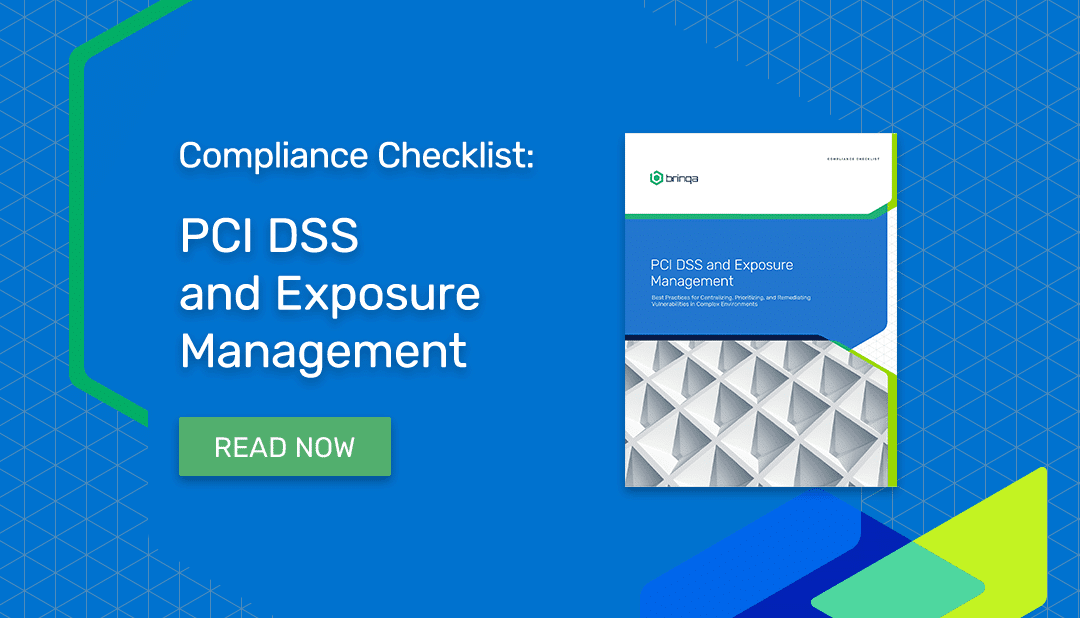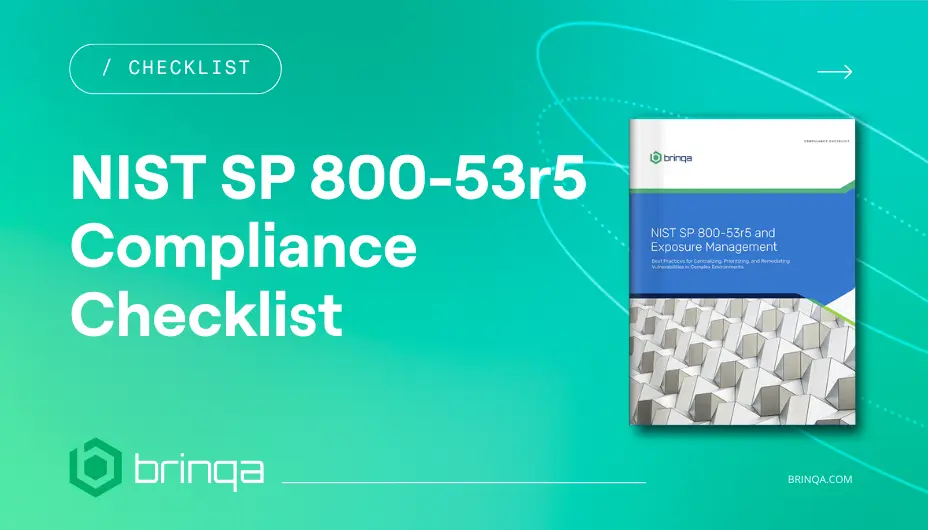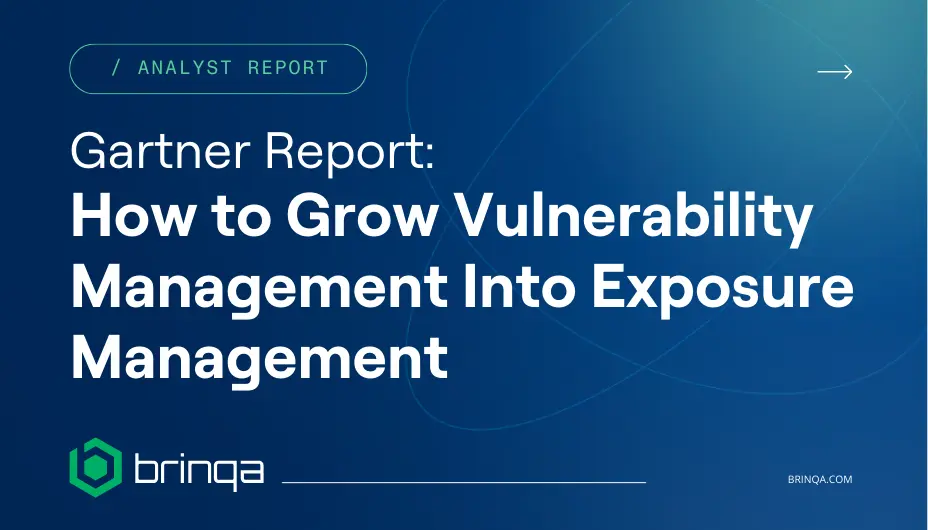PCI DSS Compliance Guide for Vulnerability Management
by Brinqa, Security Experts//10 min read/

Managing Vulnerabilities and Exposures for PCI DSS Compliance
The rise of digital payment ecosystems and the growing complexity of IT environments have made PCI DSS compliance more critical — and more challenging — than ever. As cyberattacks become more sophisticated, meeting baseline compliance is no longer enough; organizations must also ensure they have robust, risk-based controls in place to defend against real-world threats.
Protecting customer data is paramount for any organization that accepts payment cards. That’s why the PCI DSS (Payment Card Industry Data Security Standard) was created — to serve as a global standard for safeguarding cardholder data during and after financial transactions. Currently on version 4.0.1, the PCI DSS reflects evolving best practices for securing cardholder data across complex IT environments.
Developed by the PCI Security Standards Council (PCI SSC), which includes Visa, MasterCard, American Express, Discover, and JCB, the PCI DSS applies to any organization that stores, processes, or transmits payment card data — including online merchants, retailers with POS systems, payment processors, financial institutions, and third-party service providers.
For these organizations, PCI DSS compliance is not optional. It’s a contractual obligation that reduces the risk of data breaches, improves cyber hygiene, and helps avoid penalties such as increased transaction fees, lawsuits, or even the loss of payment processing privileges.
Download the complete PCI DSS Vulnerability and Exposure Management Checklist
Why Vulnerability Management Matters for PCI DSS
The PCI DSS includes strict requirements for identifying, prioritizing, and remediating vulnerabilities that could expose cardholder data. Most notably:
- Requirement 6: Develop and maintain secure systems and software.
- Requirement 11: Test the security of systems and networks regularly.
These requirements span applications, infrastructure, and networks — demanding proactive vulnerability reduction and continuous security validation.
Yet for many organizations, complying with these controls is easier said than done. Fragmented scanners, siloed asset inventories, and disjointed remediation workflows can make it difficult to get a unified view of your risk. That’s where automation, context, and exposure management come into play.
Key PCI DSS Controls for Vulnerability and Exposure Management
The following best practices align with the most relevant PCI DSS requirements and help organizations effectively manage vulnerabilities in complex environments. These controls are essential for reducing risk across systems, applications, and networks — and for demonstrating compliance with PCI DSS v4.0.1. Whether you’re looking to build a more unified risk posture or prepare for an upcoming audit, these strategies can serve as a practical foundation:
Secure Systems and Software (Requirement 6)
- Apply secure coding standards and test for vulnerabilities throughout the development lifecycle. Ingest SBOMs into your risk platform and correlate with exploitability intelligence.
- Centralize vulnerability data from scanners, SCA tools, and CI/CD pipelines to normalize findings across your tech stack.
- Enrich findings with business context like asset value, criticality, and access scope — and automate ticketing and SLA tracking via ITSM integrations.
Identify and Prioritize Vulnerabilities (Requirement 6.3)
- Unify scanner results and threat intelligence in a single source of truth. Standardize and dynamically update risk scores as your attack surface evolves.
- Prioritize based on actual risk, combining CVSS and EPSS scoring methodologies, KEV data, and exploitability signals to focus remediation where it matters most.
- Automate response workflows using business rules that assign ownership, generate tickets, and escalate based on criticality or SLA violations. Learn more about automated vulnerability remediation strategies.
Perform Vulnerability Scans and Pen Tests (Requirement 11)
- Conduct quarterly internal and external scans, including those performed by an Approved Scanning Vendor (ASV). Brinqa dashboards help track scan status and remediation progress across environments.
- Integrate penetration testing results to correlate known exploits with open vulnerabilities, helping reduce blind spots and redundant findings.
- Provide stakeholders with real-time compliance views via customizable dashboards, risk scorecards, and reporting frameworks.
Common Pitfalls in PCI DSS Vulnerability Management
Even well-intentioned teams can fall short of PCI DSS expectations due to a few recurring challenges:
- Tool fragmentation: Using multiple scanners and systems without a unified view of vulnerabilities.
- Manual processes: Tracking remediations, exceptions, and SLAs manually can lead to errors and audit gaps.
- Lack of documentation: Without proper evidence collection, it’s difficult to prove compliance during an audit.
- Inconsistent asset inventory: Missing or outdated asset data leads to blind spots in scans and reporting.
By addressing these pitfalls through automation, integration, and contextual risk scoring, security teams can better align with PCI DSS — and reduce the likelihood of fines, breaches, or failed audits.
Want the complete checklist with mapped PCI DSS v4.0.1 controls and actionable recommendations? Download the full PCI DSS and Exposure Management Checklist to align your vulnerability program with compliance requirements.

FAQ: PCI DSS and Vulnerability Management
What is PCI DSS and who must comply?
PCI DSS is a global security standard developed to protect payment card data. It applies to any organization that stores, processes, or transmits cardholder data — including merchants, processors, financial institutions, and service providers.
Which PCI DSS requirements are most relevant for vulnerability management?
Requirements 6 and 11 are directly related. Requirement 6 covers secure system development and vulnerability management processes. Requirement 11 focuses on scanning and penetration testing.
What tools are required for PCI DSS vulnerability compliance?
Organizations typically need vulnerability scanners, secure coding tools, patch management systems, and penetration testing services — all ideally integrated into a centralized risk platform like Brinqa.
How often are vulnerability scans required under PCI DSS?
Internal and external vulnerability scans must be conducted at least once every three months. To remain compliant, organizations must demonstrate four passing scans annually. External scans must be performed by an Approved Scanning Vendor (ASV), and additional scans are required after any significant changes. Internal and external vulnerability scans must be conducted quarterly, with external scans performed by an Approved Scanning Vendor (ASV). Additional scans are required after significant changes.
What counts as a “significant change” that triggers new scans or testing under PCI DSS?
Significant changes can include network topology modifications, system upgrades, application deployments, or any configuration changes that may impact security. These changes typically require immediate vulnerability scans and possibly additional penetration testing.
How should organizations document vulnerability remediation for PCI audits?
Organizations should maintain clear records of vulnerability scan results, ticketing workflows, remediation timelines, patch deployments, and change approvals. A centralized platform like Brinqa can automate evidence collection and generate audit-ready reports.
What are the biggest challenges for vulnerability management teams under PCI DSS?
Common pain points include tool sprawl, lack of centralized visibility, manual prioritization efforts, and difficulty proving compliance. Exposure management platforms help address these challenges through automation, integration, and contextual scoring.
How Brinqa Helps
Brinqa’s Vulnerability and Exposure Management Platform — powered by the Cyber Risk Graph™ — enables security teams to prioritize remediation based on business risk, not just compliance checkboxes. It consolidates findings from across the tech stack, enriches them with threat intelligence, and automates remediation workflows to accelerate PCI DSS compliance.
With Brinqa, you can:
- Centralize vulnerability data from 220+ tools across infrastructure, cloud, and applications.
- Automatically apply exploitability intelligence and risk context to prioritize critical fixes.
- Orchestrate remediation with bidirectional integrations for Jira, ServiceNow, GitLab, and more.
- Provide real-time dashboards for audit readiness and stakeholder alignment.
Download the full PCI DSS checklist or Request a Demo to see how Brinqa helps organizations automate and mature their PCI compliance processes.


